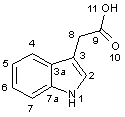
Ferreira M. M. C., Kiralj R., "Relationships Between Crystal, Molecular, Physico-Chemical and Biological Properties of Alkylated 1H-Indole-3-Acetic Acids". Caxambu, MG, 23-26/11/2003: 12° Simpósio Brasileiro de Química Teórica (XII SBQT) [12th Brazilian Symposium of Theoretical Chemistry], Livro de Resumos [Book of Abstracts], (2003) P151. Poster P151.
|
|
RELATIONSHIPS
BETWEEN CRYSTAL, MOLECULAR
PHYSICO-CHEMICAL
AND BIOLOGICAL PROPERTIES OF
ALKYLATED
1H-INDOLE-3-ACETIC ACID
Rudolf
Kiralj (PQ), Márcia M. C. Ferreira (PQ),
rudolf@iqm.unicamp.br
Instituto
de Química - UNICAMP, Campinas SP, 13084-971 Brazil.
Palavras-chave: alkylated 1H-indole-3-acetic acids, molecular mechanics, PLS
1H-Indole-3-acetic acid (IAA, Scheme) and
its alkylated derivatives are known as
important plant-growth regulation
hormones from auxin class. In general, relationships between
structure and activity for
IAA derivatives have never been straightforward for a long time, mainly
due to the lack of a 3D
structure of an auxin receptor, intrinsic auxin properties,
and existence
of heterogeneous
measurements of auxin biological
properties (plant-growth promoting
activity). Usually
IAA auxins are limited to derivatives with small substituents at five substitution
positions at the indole
ring (2, 4, 5, 6 and 7).
This work deals with IAA and its 10 alkylated derivatives: 2-Me-,
4-Me-, 5-Me-, 6-Me-,
7-Me-, 4-Et-, 5-Et-, 6-Et-,
5-Pr- and 5-Bu-IAA [1]. The following IAAs properties were studied: a)
crystal packing parameters
based on crystal structures retrieved from the Cambridge Structural
Database (unit cell
volume per molecule, crystal density,
average atomic volume, packing
coefficients,
number of hydrogen bonds,
total number of intermolecular
interactions,
coordination number);
b) molecular properties calculated for the
IAAs based on molecular
ormula (relative molecular
mass, %carbon & hydrogen) and based on geometry obtained
from
crystal structures
or optimized by molecular
mechanics MMFF94 (with Montecarlo
conformational search) or
ab
initio B3LYP 6-31G** (ovality, molecular volume, Conolly
surface
rea and volume, torsion
angles T1: C2-C3-C8-C9 and T2: C3-C8-C9-O10);
c) experimental
physico-chemical properties
[1] (octanol-water partition coefficient in logarithmic form,
average
proton NMR shift
for indole ring); d) biological activity
on Avena Sativa L. coleoptiles [1]
(logarithmof auxin
molar concentration measured at the half-maximum
coleoptile elongation).
T1 and T2 and
Zn-O bond lengths from auxin binding protein 1 (ABP1)
[2] – IAA complexes
optimized at MMFF94
level were also used. Correlations
including all the properties were
studied, and partial
least regression models (PLS) were built to
predict dependent variables
(crystal density,
average atomic volume, packing coefficient, unit
cell volume per molecule,
physico-chemical and
biological properties) on independent
ones (all other descriptors).
Conformational properties expressed as T1 and T2
of IAAs in vacuum, crystal and
complex with
ABP1 show significant variations, and
also differences in correlations with
dependent variables and
in significance in PLS models. Besides, there are notable differences
in using different optimization
schemes after the conformational search. Correlation
analysis
showed important
linear and non-linear correlations between properties
of the same kind or
different kinds (crystal,
molecular, physico-chemical, biological). Parsimonius
PLS regression
models (Q > 0.70,
R > 0.85) were built for most of the dependent variables.
As alkylated IAAs
make a homogeneous set of
auxins, the established relationships are reasonable.
(FAPESP)

Scheme. 1H-indole-3-acetic acid
[1] B. Nigovic et al., Acta
Cryst. B56 (2000) 94.
[2] E.-J. Woo et al., EMBO
J. 21 (2002) 2877.